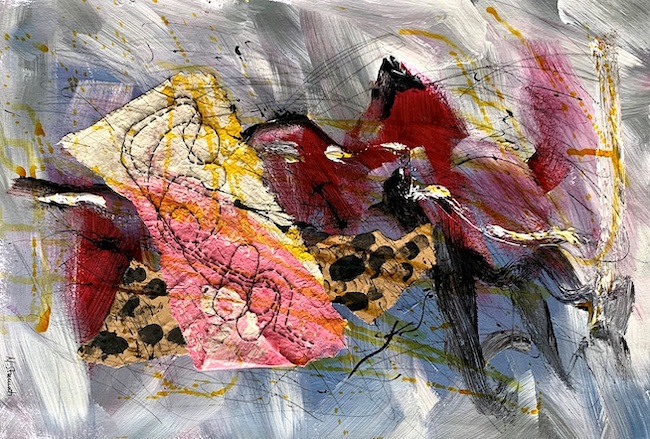La manifestazione artistica astratta si pone spesso come mezzo per comunicare le sensazioni, le emozioni che appartengono al mondo interiore e che necessitano di fuoriuscire ed essere nel contempo comprese, accolte, osservate dal di fuori, oppure come strumento razionale e schematico funzionale a dare un ordine plastico e concettuale a forme distanti dalla rappresentazione della realtà. La protagonista di oggi riesce a modulare e mescolare l’istintualità creativa e la ricerca concettuale dando alle sue opere un equilibrio tra impulso e riflessione.
La nascita del movimento pittorico fondato da Jackson Pollock decretò di fatto una contestazione degli artisti che vi aderirono, tra cui Mark Rothko, Wilhelm de Kooning, Franz Kline solo per citarne alcuni, nei confronti dell’Astrattismo Geometrico e del Concettuale che si era notevolmente diffuso in Europa e in virtù del quale l’arte diventò un mondo matematico, scientifico, volto ad affermare la supremazia dell’atto creativo su tutta la realtà osservata che poteva essere facilmente e meccanicamente riprodotta grazie all’avvento, e alle successive evoluzioni, della nuova tecnologia fotografica. Ciò che doveva essere escluso dall’Astrattismo Geometrico, dal Suprematismo e dal Neoplasticismo, e che trasformò l’opera d’arte in una pura astrazione ma anche in una ricerca sul significato intrinseco dell’atto stesso del dipingere o del creare, volle invece essere assolutamente recuperato dagli espressionisti astratti per cui era impossibile concepire una tela senza che al suo interno vi fossero impresse le sensazioni e le emozioni più forti e intense, quelle che dovevano fuoriuscire dall’interiorità senza essere filtrate dalla mente razionale. E la libertà espressiva fu l’unica regola, denominatore comune dell’eterogeno gruppo di artisti che aderirono all’Espressionismo Astratto, ciascuno con la propria sensibilità e il proprio personale modo di aprire il dialogo con la tela che passava dall’atto irruento e impulsivo di Jackson Pollock, il cui Dripping contraddistinse un nuovo modo di usare il colore, a quello più meditato ed empirico di Mark Rothko, a quello più minimalista di Barnett Newmann. Questi grandi artisti del Novecento segnarono un percorso nuovo nel mondo dell’arte, a partire dal quale nuove forme pittoriche ed evoluzioni artistiche si sono susseguite e ancora contraddistinguono molti tra i principali protagonisti dell’arte contemporanea come Gerard Richter, tra i maggiori rappresentanti mondiali di questo tipo di approccio pittorico, nonché uno degli artisti più quotati al mondo. Non solo, l’apertura alla varietà espressiva fu un’innovazione in un’epoca in cui sembrava necessario appartenere a una corrente o a un movimento per attrarre l’attenzione di un sistema dell’arte, quello dei grandi musei e delle gallerie, che troppo spesso non era pronto ad accogliere le innovazioni imposte e fortemente gridate dai protagonisti del mondo creativo dell’epoca, ha spianato la strada agli artisti contemporanei nel lasciar fluire la propria creatività senza schemi di appartenenza, senza gabbie e con la spontaneità di poter mescolare caratteristiche stilistiche differenti al fine di ricercare un proprio personale linguaggio. Maria Stamati, artista greca con alle spalle un lungo percorso di riconoscimenti e successi, di numerose esposizioni collettive e personali in Grecia e all’estero, è contraddistinta da uno stile particolare in cui l’irrazionale, l’impulso, viene mitigato e modulato attraverso una riflessione per la quale diviene necessario l’uso della materia in modo lieve però, non invasivo né eccessivamente tridimensionale, proprio per lasciare all’osservatore quel senso di equilibrio misurato che fuoriesce dalle sue tele.
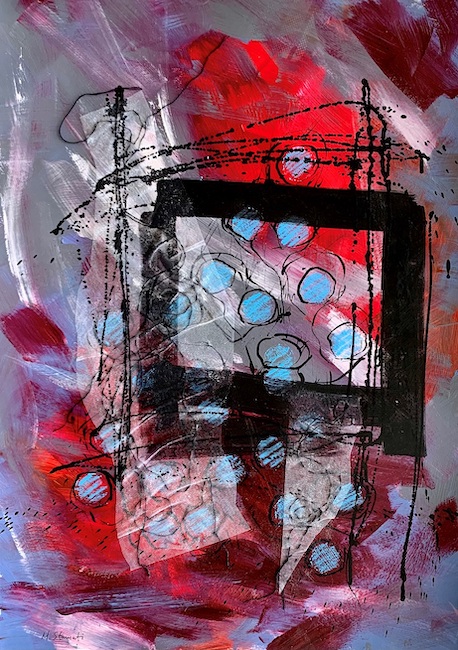
Il punto di vista è quello di un’emotività bilanciata dalla consapevolezza di sé, quella terra di mezzo tra tutto ciò che è incontrollabile e dunque parte dell’irrazionalità appartenente a ciascun individuo, e ciò che invece viene filtrato dalla naturale tendenza all’ascolto, alla comprensione e alla necessità di chiarire, nella maggior parte dei casi a se stessi, quella parte istintiva generante le tempeste emotive che avvolgono e spesso dominano l’esistenza.
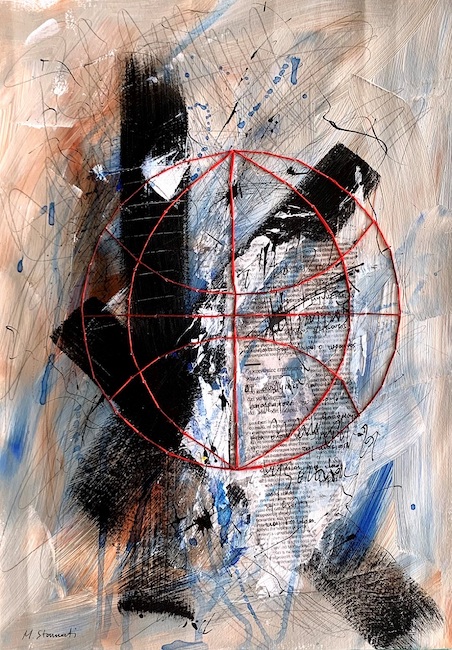
Attraverso i colori e la forma a fuso della parte astratta Maria Stamati sembra voler raccontare quel mondo di sensazioni, quel groviglio incomprensibile con cui l’individuo si trova costantemente a dover fare i conti, quel sentirsi trascinato da forze interne ed esterne che tendono a farlo sentire spettatore di quanto accade intorno a lui mentre in realtà ne è inconsapevole quanto assoluto protagonista; poi in virtù della materia utilizzata per l’interazione con le tonalità scelte per raccontare la singola emozione, l’artista prova a trovare una spiegazione, un procedimento logico e consapevole necessario a prendere atto e coscienza del fatto che gli eventi dell’esistenza non devono essere subìti bensì affrontati e accolti come parte del proprio percorso.
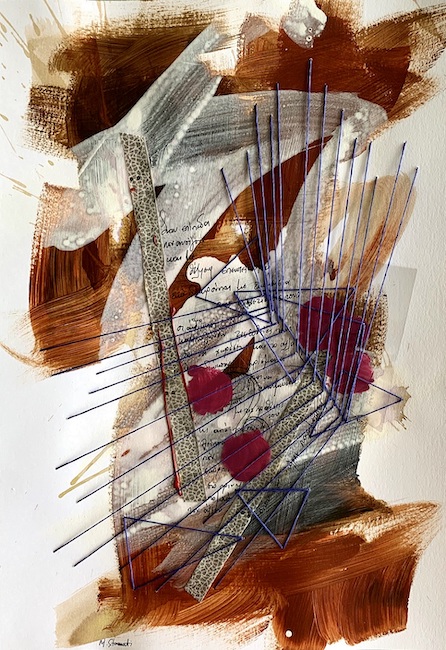
La tela To fit in the before and after of another (Per adattarsi al prima e al dopo di un altro) racconta esattamente di questo tipo di apertura, quell’interazione che nasce con qualcuno che entra nell’esistenza dell’altro e a cui diviene inevitabile adattarsi, creare una sintonia attraverso la conoscenza e la comprensione per riuscire a creare un percorso condiviso; il prima e il dopo della persona che ci si trova davanti, sembra dire Maria Stamati, non possono prescindere dal cammino che si sceglie di fare insieme, è per questo che all’interno dell’opera pone elementi materici come la plastica e il sottile filo attraverso cui l’artista unisce simbolicamente l’interiorità e l’emotività di due persone.
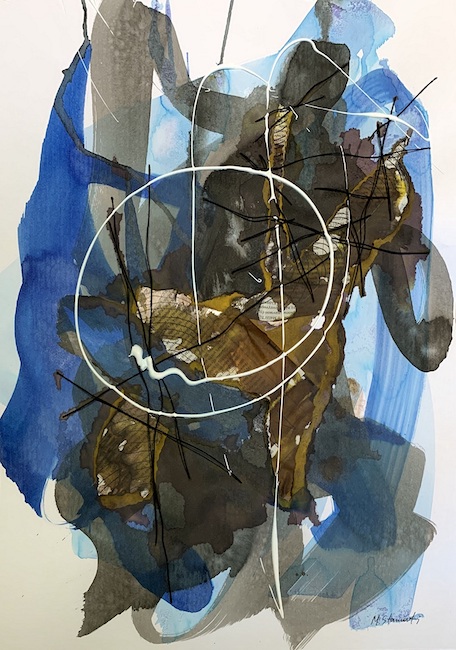
In Position in anticipation (Posizione in previsione) il senso del movimento, del tendere verso il dopo appena accennato dal titolo, quel progredire verso un’incognita che la natura umana cerca sempre di prevedere, di pronosticare oppure a cui semplicemente prepararsi, è perfettamente narrato attraverso le volute cromatiche, l’ondulazione morbida accordata all’andamento altalenante degli accadimenti che, malgrado l’individuo tenti di controllare, in realtà sfuggono a ogni regola, a ogni pronostico. Tutto ciò, molto più spesso di quanto si sia portati a credere, è positivo poiché è proprio in virtù dell’imprevedibile che si aprono opportunità insperate; il cerchio bianco al centro dell’opera sembra voler contenere le opzioni e controllarle attraverso la razionalità, eppure qualcosa sfugge, quelle macchie di colore terroso oltre i limiti contrassegnati dal filo scuro, come se un lembo di casualità rifiutasse di sottostare alle regole della mente.
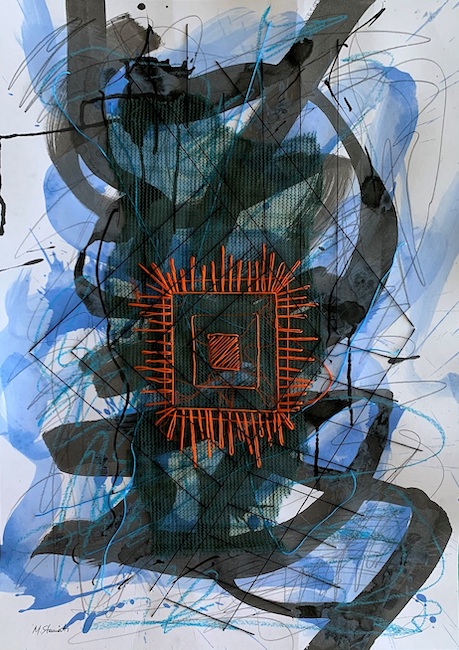
E ancora, nel lavoro Code (Codice) Maria Stamati indaga sulla natura di ciascuno, su quel patrimonio genetico dietro cui spesso l’individuo tende a nascondersi rassegnandosi a non cambiare ciò che invece potrebbe, ignorando che invece è nel suo potere di andare anche contro ciò che sembra prestabilito, ineluttabile, segnato per destino; il simbolo posto al centro dell’opera, e realizzato con del filo rosso, dunque elemento materico per sottolineare l’importanza della scelta, rappresenta un segno personale e unico che appartiene non tanto alla propria natura quanto alla volontà e alla determinazione di prendere in mano la vita e modificare tutto ciò che apparentemente sembra predestinato.
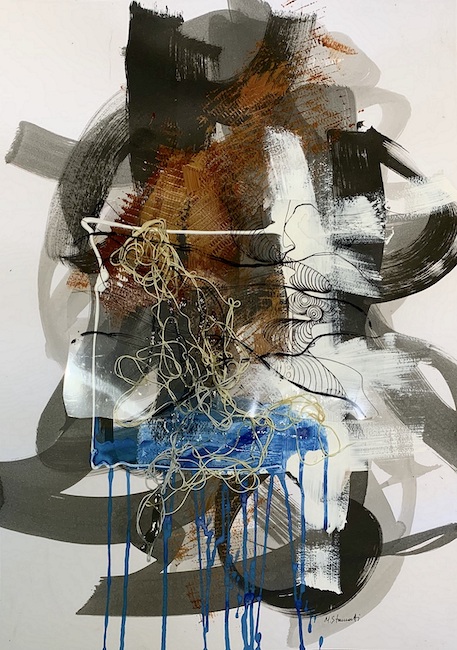
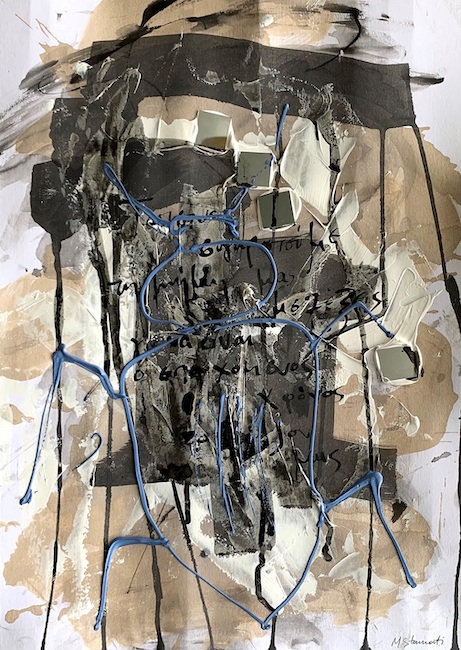
Emerge in maniera nitida e chiara dalle opere di Maria Stamati, la sicurezza di chi ha compreso che le emozioni possono diventare elemento fondamentale per la conoscenza di se stessi e per trovare un equilibrio, un bilanciamento tra le due parti che appartengono irrimediabilmente alla natura umana, quella cioè più istintuale e impulsiva, e quella che pur non volendo controllare l’incontrollabile, cerca di comprenderne il senso, il motivo, per poi integrarlo nel percorso di conoscenza. Ed è esattamente questo il fascino delle opere pittorico-materiche di Maria Stamati, che ha all’attivo venti mostre personali in Grecia, ha vinto sei premi d’arte, ha pubblicato sei raccolte di poesie e le sue opere sono nelle copertine di un grande numero di libri.
MARIA STAMATI-CONTATTI
Email: stamati_maria@hotmail.com
Sito web: www.stamatimaria.gr
Facebook: https://www.facebook.com/stamatimaria
A journey into the irrational in Abstract Expressionism by Maria Stamati
Abstract art often acts as a means of communicating sensations and emotions that belong to the inner world and need to escape and be understood, accepted and observed from the outside at the same time, or as a rational and schematic tool for giving a plastic and conceptual order to forms that are distant from the representation of reality. Today’s protagonist manages to modulate and mix creative instinctuality and conceptual research, giving her artworks a balance between impulse and reflection.
The birth of the painting movement founded by Jackson Pollock was a de facto protest by the artists who adhered to it, including Mark Rothko, Wilhelm de Kooning and Franz Kline, to name but a few, against the Geometric Abstractionism and Conceptualism that had spread widely in Europe and by virtue of which art became a mathematical, scientific world, aimed at asserting the supremacy of the creative act over all observed reality, which could be easily and mechanically reproduced thanks to the advent, and subsequent developments, of the new photographic technology. What had to be excluded from Geometric Abstractionism, Suprematism and Neoplasticism, and which transformed the artworks into pure abstraction but also into a search for the intrinsic meaning of the very act of painting or creating, wanted instead to be absolutely recovered by the Abstract Expressionists for whom it was impossible to conceive of a canvas without the strongest and most intense sensations and emotions being impressed on it, those that had to come out of the interior without being filtered by the rational mind.
And freedom of expression was the only rule, the common denominator of the heterogeneous group of artists who adhered to Abstract Expressionism, each with his own sensitivity and his own personal way of opening a dialogue with the canvas that went from the impetuous and impulsive act of Jackson Pollock, whose Dripping marked a new way of using colour, to the more meditated and empirical one of Mark Rothko, to the more minimalist one of Barnett Newmann. These great artists of the 20th century marked a new path in the art world, from which new pictorial forms and artistic evolutions followed one another and still characterise many of the main protagonists of contemporary art such as Gerard Richter, one of the world’s leading representatives of this type of pictorial approach and one of the most highly quoted artists in the world. This openness to expressive variety was an innovation at a time when it seemed necessary to belong to a current or a movement to attract the attention of an art system, that of the great museums and galleries, which all too often was not ready to accept the innovations imposed and loudly shouted by the protagonists of the creative world of the time. It has paved the way for contemporary artists to let their creativity flow without belonging to any schemes, without cages and with the spontaneity of being able to mix different stylistic characteristics in order to seek their own personal language.
Maria Stamati, a Greek artist with a long history of awards and success, of numerous group and solo exhibitions in Greece and abroad, is distinguished by a particular style in which the irrational, the impulse, is mitigated and modulated through a reflection for which it becomes necessary to use the material in a light but not invasive nor excessively three-dimensional way, precisely to leave the observer with a sense of measured balance that emerges from her canvases. The point of view is that of an emotionality balanced by self-awareness, that middle ground between everything that is uncontrollable and therefore part of the irrationality belonging to each individual, and what is instead filtered by the natural tendency to listen, to understand and to clarify, in most cases to oneself, that instinctive part that generates the emotional storms which envelop and often dominate existence. Through the colours and the spindle shape of the abstract part, Maria Stamati seems to want to recount that world of sensations, that incomprehensible tangle with which the individual is constantly having to come to terms, that feeling dragged by internal and external forces that tend to make him feel like a spectator of what is happening around him while in reality he is an unaware absolute protagonist; then by virtue of the material used for the interaction with the tones chosen to narrate the individual emotion, the artist tries to find an explanation, a logical and conscious procedure necessary to become aware and conscious of the fact that the events of existence must not be suffered but faced and accepted as part of one’s own journey.
The canvas To fit in the before and after of another tells exactly about this kind of openness, that interaction that arises with someone who enters the existence of another and to whom it becomes inevitable to adapt, to create a harmony through knowledge and understanding in order to be able to create a shared path; The before and after of the person in front of us, Maria Stamati seems to say, cannot be separated from the path we choose to take together, which is why she places material elements such as plastic and the thin thread through which symbolically unites the interiority and emotions of two people. In Position in anticipation, the sense of movement, of tending towards the aftermath, which is barely hinted at by the title, that progress towards an unknown that human nature always tries to foresee, to predict or simply prepare for, is perfectly narrated through the chromatic swirls, the soft undulation tuned to the swinging course of events which, despite the individual’s attempts to control them, in reality escape all rules and all predictions. The white circle at the centre of the artwork seems to want to contain the options and control them through rationality, yet something escapes, those patches of earthy colour beyond the limits marked by the dark thread, as if a strip of randomness refused to submit to the rules of the mind.
And again, in Code Maria Stamati investigates the nature of each person, that genetic heritage behind which the individual often tends to hide, resigning himself to not changing what he could, ignoring the fact that it is in his power to go against what seems pre-established, ineluctable, marked by destiny; the symbol in the centre of the work, made of red thread, a material element that underlines the importance of choice, represents a personal and unique sign that belongs not so much to one’s own nature as to the will and determination to take life into one’s own hands and change everything that apparently seems predestined. Maria Stamati’s artworks clearly reveal the certainty of someone who has understood that emotions can become a fundamental element for self-knowledge and for finding a balance between the two parts that irretrievably belong to human nature, that is, the more instinctual and impulsive part, and the part that, although it does not want to control the uncontrollable, tries to understand its meaning, the reason, and then integrate it into the path of knowledge. This is precisely the fascination of the pictorial-material artworks of Maria Stamati, who has had twenty solo exhibitions in Greece, won six art prizes, published six collections of poetry and whose works are on the covers of a large number of books.
MARIA STAMATI-CONTACTS
Website: www.stamatimaria.gr
Facebook: https://www.facebook.com/stamatimaria


